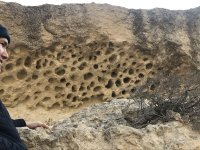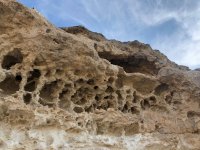You are using an out of date browser. It may not display this or other websites correctly.
You should upgrade or use an alternative browser.
You should upgrade or use an alternative browser.
What are these holes???
- Thread starter aliny
- Start date
broken_detector
Sr. Member
- Mar 10, 2013
- 468
- 666
- Detector(s) used
- Minelab Equinox 800, Garrett AT Pro, Whites Classic ID, Mikronta 4003
- Primary Interest:
- Relic Hunting
Believe it was an underground ant colony.
Upvote
0
What part of the country was this feature found in? 
Looks like New Mexico, Texas or California... this would help narrow it down.
Dave
Looks like New Mexico, Texas or California... this would help narrow it down.
Dave
Upvote
0
I think it is tufa, although I have not seen it in a honeycomb shape like that. The second picture looks more like tufa.
https://www.google.com/search?q=tuf...VUIzQIHXI1AU0Q4lYoBnoECAEQHA&biw=1343&bih=632
https://www.google.com/search?q=tuf...VUIzQIHXI1AU0Q4lYoBnoECAEQHA&biw=1343&bih=632
Upvote
0
danloop
Full Member
- Feb 16, 2014
- 195
- 198
- Detector(s) used
-
Unicorn Treasure Master Pro
Modes:
Dowsing
Pulse Induction
Multi-Frequency
Ground Penetrating Radar
Beat Frequency Oscillation
Aural Target Identification
- Primary Interest:
- Metal Detecting
noo, it is a Central Asia, Kazakhstan, probably it is unfamiliar to you
Sounds like you already know.
Upvote
0
bowwinkles
Bronze Member
- Nov 3, 2012
- 2,078
- 2,426
- Primary Interest:
- All Treasure Hunting
I have seen this many times in Oregon.
https://www.google.com/search?q=pic...oAhXGmuAKHUTmArEQ7Al6BAgFECk&biw=1226&bih=552
https://www.google.com/search?q=pic...oAhXGmuAKHUTmArEQ7Al6BAgFECk&biw=1226&bih=552
Upvote
0
Plug N Play
Bronze Member
- Aug 23, 2014
- 1,315
- 3,573
- Detector(s) used
- De Havilland Canada DHC-7-102 Dash 7 - Fugro
- Primary Interest:
- All Treasure Hunting
Pitted limestone
" Especially in dry environments, or in the sheltered areas of wetter climates, it is common to see the pitting of limestone surfaces. Examination under high magnification by scanning electron microscope often reveals that the interiors of these pits are colonised by communities of algae, fungi and bacteria. These help to dissolve the stone, and in doing so create tiny ecological niches that encourage further colonisation. "
" Especially in dry environments, or in the sheltered areas of wetter climates, it is common to see the pitting of limestone surfaces. Examination under high magnification by scanning electron microscope often reveals that the interiors of these pits are colonised by communities of algae, fungi and bacteria. These help to dissolve the stone, and in doing so create tiny ecological niches that encourage further colonisation. "
Upvote
0
Top Member Reactions
-
 2579
2579 -
 1166
1166 -
 1073
1073 -
 885
885 -
 851
851 -
 851
851 -
 786
786 -
 687
687 -
 629
629 -
 579
579 -
 489
489 -
 478
478 -
 475
475 -
 469
469 -
 464
464 -
 428
428 -
O
416
-
 391
391 -
 379
379 -
 363
363
Users who are viewing this thread
Total: 2 (members: 0, guests: 2)





